TESTS SHOW BENEFITS OF NEW POLISHED ROD LUBRICATOR
Michael R. Tyler,
Alan Khatib
Rocky Mountain Oilfield Testing Center
Casper, Wyo.
Tests with beam-pumped oil wells, completed over 7-months at the Rocky Mountain Oilfield Testing Center (Rmotc), indicated that a new lubricator supplying supplementary grease to polished rods lowered operating costs by reducing maintenance, material costs, and electrical requirements.
It also minimized polished rod corrosion and enhanced pollution control.
The lubricator worked with extremely hot fluids and in adverse weather conditions.
RMOTC
Rmotc is at Naval Petroleum Reserve No. 3 (NPR-3) also known as the Teapot Dome oil field in Natrona County, near Casper, Wyo. NPR-3 is the only 100% U.S. government-owned oil field. Fluor Daniel manages and operates the field for the U.S. Department of Energy (DOE).
The activities at Rmotc are in line with the Secretary of Energy's mandates to use the Naval petroleum reserves for advanced technology testing, evaluation, and training in new oil field and environmental technologies.
Teapot Dome has nine producing horizons, ranging in depth from 300 to 6,000 ft. Currently there are 571 producing and 76 injection wells. Many different types of wells are available for testing. Rmotc also has video/teleconferencing equipment and extensive data bases for computer geologic mapping.
Although subcontractors are used at times, NPR-3 is a self-contained operation that provides great flexibility.
On site support includes water treatment and disposal facilities, steam generators, drilling and workover rigs, heavy equipment, etc. NPR-3 also has a stable and highly trained workforce that is knowledgeable in environmental, safety, and health compliance.
NEW LUBRICATOR
The lubricator holds 6 lb of grease that is continuously pumped at a rate determined by the operator. The benefits of the unit are as follows:
- Extends stuffing box life by reducing friction between the polished rod and packing that can cause heat damage.
- Protects the polished rod from electrolysis and corrosive production fluids
- Lessens the risk/frequency of stuffing box leaks that can affect the environment
- Reduces labor requirements per well because less time is spent packing stuffing boxes
- Reduces electrical consumption.
TEST WELLS
The lubricator was tested on four wells at NPR-,3 from Dec. 3, 1993, through July 1, 1994. these wells produce from two formations: the Shannon (SX) at about 300 ft and the Second Wall Creek (AX) at about 2,300 ft.
The SX wells are in the steam flood portion of the Shannon formation. Here, wellhead temperatures reach 188 F.
The Second Wall Creek wells were selected because their produced water is corrosive.
The lubricators operated reliably in weather conditions that varied from extreme cold to intense heat.
On Well 5245-SX-10, a problem with the polished rod hanging up and the bridle being thrown from the unit did not recur after installation of the new lubricator.
There were no spills or other pollution problems while the lubricators were operating.
This avoided downtime, lost production, and extra man-hours for maintenance and cleanup of equipment and the environment, which are common problems in the oil field
COST REDUCTION
On well 38-1-AX-34, equipped with a 7.5 hp (5.6 kw) energy-efficient motor, the electrical consumption measured with a Dranetz Energy analyzer confirmed an 8% reduction in electricity, as anticipated by the manufacturer. At NPR-3, electricity costs $0.027/kw-hr.
The lubricator reduced maintenance time by 36 man-hr/well/year. Costs also were saved because of reduced well downtime and longer stuffing-box packing life.
Materials for repacking a stuffing box cost an average of $23. On the test wells, the frequency of repacking stuffing boxes was reduced by 50%, from eight to four times/year. Average well downtime for repacking a stuffing box is 30 min.
Based upon Well 38-1-AX-34, which has an energy efficient motor, payout (Table 1 (13515 bytes)) of the lubrication system will be 9 months. Note that results could be even more significant on wells equipped with standard or over-sized motors.
In these tests, the grease cost was about $235/year. Because grease is a significant cost component of this system, modification of the lubricator to apply grease as required, rather than continuously, would reduce operating expenses.



